The confluence of artificial intelligence (AI) with creative industries such as art and music is pioneering a novel paradigm in which machines are not just tools, but participants in the creative process. Generative AI is at the forefront of this shift, harnessing algorithms and machine learning to produce work that resonates with human emotional depth and aesthetic complexity. This technology enables a symbiotic relationship where AI augments human creativity, offering artists and musicians new avenues to explore their crafts and realize ideas that were once beyond reach.

AI’s impact on creativity is not limited to generating novel artworks or compositions; it also promises to democratize the creative process. With tools powered by AI, individuals lacking traditional training can now engage in artistic creation, blurring the lines between expert and novice. Musicians and designers are embracing AI to experiment with patterns and structures, pushing the boundaries of what is conventionally considered possible in their fields.
However, the integration of AI into creative domains also raises critical discussions about authorship, originality, and the essence of human versus machine-generated artistry. While AI pushes creativity to new horizons, it also spawns debate regarding the value and recognition of AI-produced artifacts compared to those made solely by humans. This intersection of AI and human creativity is not only redefining traditional art forms but also questioning the very nature of innovation in the digital age.
Foundations of AI in Creative Domains

Exploring the foundations of AI in creative domains reveals a complex interplay of history, technology, and artistry. These domains encompass the evolution and application of artificial intelligence in art and music, the core concepts underpinning machine learning, and the nuanced understanding of artificial creativity.
History of AI in Art and Music
The inception of AI in art and music dates back to early experiments with algorithmic composition and computer-generated paintings. Early pioneers in the 1960s and 1970s, such as Harold Cohen with his AARON program, paved the way for the computer-generated art. In music, Iannis Xenakis and David Cope were instrumental in integrating AI to produce novel compositions, illustrating the potential of machines in creative industries.
Core Concepts of Machine Learning
Machine learning forms the bedrock of AI’s creative applications. It involves training algorithms to recognize patterns and make decisions with minimal human intervention. Two fundamental machine learning concepts critical in creative applications are:
- Supervised Learning: Involves labeled datasets to teach algorithms to predict outcomes. This is used in applications like style transfer, where an AI learns to apply the style of one image to another.
- Unsupervised Learning: Relies on algorithms identifying patterns without explicit guidance, crucial for generating unique pieces of art or music with no direct human precedent.
Understanding Artificial Creativity
Artificial creativity is characterized by the ability of AI systems to produce works that are novel and valuable. It is distinguished by:
- Generativity: AI’s capacity to produce a vast amount of diverse creative output quickly.
- Adaptability: The proficiency of AI in learning from new inputs and adjusting its creative processes accordingly.
AI’s creativity is often judged by the standards of human aesthetics and innovation, leading to discussions around the true nature of creativity and whether it can be authentically replicated or augmented by artificial means.
AI-Driven Artistic Tools
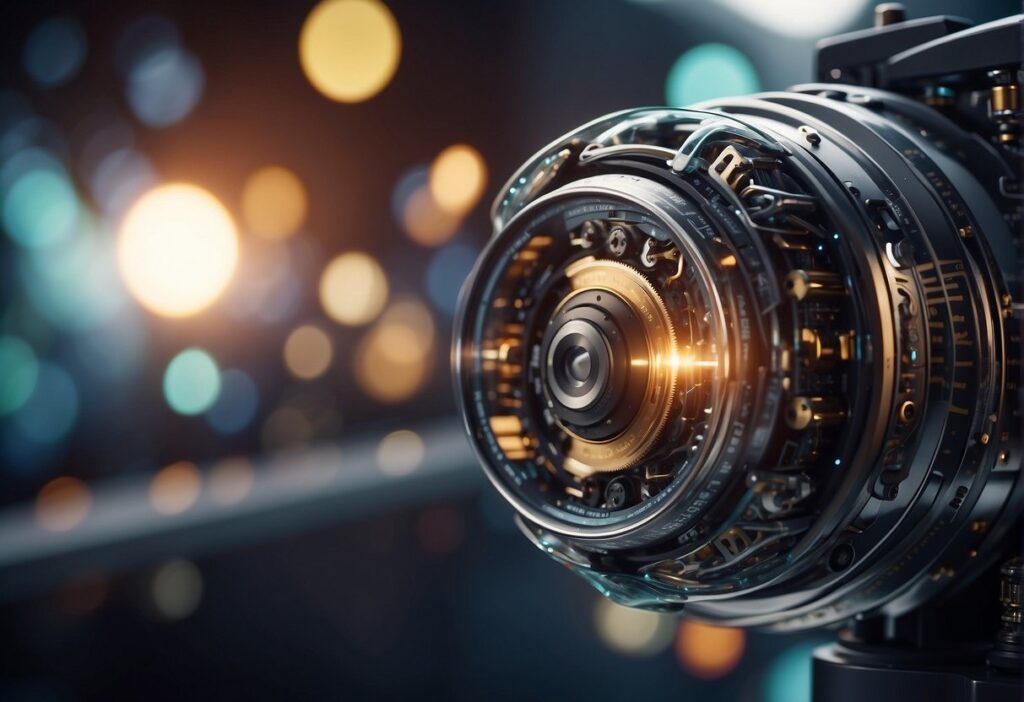
The emergence of AI-driven artistic tools marks a pioneering shift in the creative landscape, one where the lines between technology and human artistry are increasingly blurred.
Generative Adversarial Networks for Art
Generative Adversarial Networks (GANs) revolutionize the creation of visual art, enabling artists to produce intricately detailed and novel imagery. This technology pits two neural networks against each other — one generating content, the other judging it — iterating until the output can fool human observers. These networks have been pivotal in projects involving high-resolution image generation.
Evolutionary Algorithms in Music Composition
Evolutionary algorithms take a cue from natural selection to breed new musical compositions. These algorithms test numerous permutations of melodies and harmonies, gradually selecting and refining those that best meet a set of defined criteria. This method has fostered new forms of algorithmic symphonies and dynamic soundscapes.
AI in Video Game Design
AI profoundly impacts video game design by automating labor-intensive tasks and yielding adaptive, responsive virtual environments. Designers employ AI not just in character behavior, but also in level creation and aesthetic refinement, ensuring a tailored gaming experience. Games now offer dynamic content generation, with AI altering play in real-time to match player skill levels and preferences.
Machine Learning Models in Creation

Machine learning models have significantly advanced the realms of art, music, and interactive media by introducing novel ways of creation and expression. These models harness the power of algorithms to analyze vast datasets, learn from them, and generate creative outputs that often echo human creativity, sometimes with a distinctive computational flair.
Deep Learning for Style Transfer
Deep learning, particularly through the use of convolutional neural networks (CNNs), has catalyzed the emergence of style transfer in visual art. This technique involves the application of the stylistic elements of one image to the content of another, effectively morphing the aesthetic of famous artworks onto user-provided images. Projects like Adobe’s neural filters are illustrative of this, seamlessly blending styles from one image to another.
Natural Language Processing for Lyric Generation
Transitioning from visual art to music, natural language processing (NLP) models have been instrumental in lyric generation. These models can parse through extensive corpuses of musical lyrics, learn patterns, rhyming structures, and themes, and then generate new lyrics that resonate with the style or mood of a particular artist or genre. For instance, models utilizing Transformer architectures can create lyrics that maintain coherence over the length of a song.
Reinforcement Learning in Interactive Art
In the sphere of interactive art, reinforcement learning (RL) paves the way for dynamic pieces that respond to audience input. This type of machine learning involves agents that learn how to behave in an environment by performing actions and observing the results. Interactive installations employing RL can evolve over time or alter their behavior in real-time as they ‘learn’ from the interactions of viewers, fostering an immersive and personalized art experience.
Human-AI Collaboration

Human-AI collaboration in the creative fields is evolving, featuring diverse intersections where humans and AI systems co-create in art, music, and beyond. This collaboration is reshaping the traditional boundaries of creativity and performance.
Artists’ Perspectives on AI Collaboration
Artists working with AI view it as a transformative tool that augments the creative process. For instance, AI in art and creativity is seen not just as a tool but as an active collaborator that can suggest new forms and elements an artist might not have considered. As AI systems learn from each interaction, they reflect a partnership where artists’ skills are complemented by the machine’s data-driven suggestions and novel patterns.
The Role of AI in Live Performances
In the realm of live performances, AI’s role cannot be understated. It enhances the experience both for the audience and the performers. Complex algorithms help in creating dynamic music pieces that adapt to the performer’s style or the audience’s reactions in real-time. This creates a unique and responsive environment that is different for every performance, showcasing a new level of interaction between humans and machines.
Ethical Considerations in AI Art
When it comes to the ethics of AI-generated art, questions often arise regarding originality and authorship. There are concerns about the potential for AI to replicate styles and themes without understanding their cultural significance, raising debates on intellectual property rights. Proponents of AI in creativity argue for the establishment of guidelines that ensure responsible use, aiming to maintain artistic integrity and genuine human-machine collaboration.
Impacts on the Creative Industry
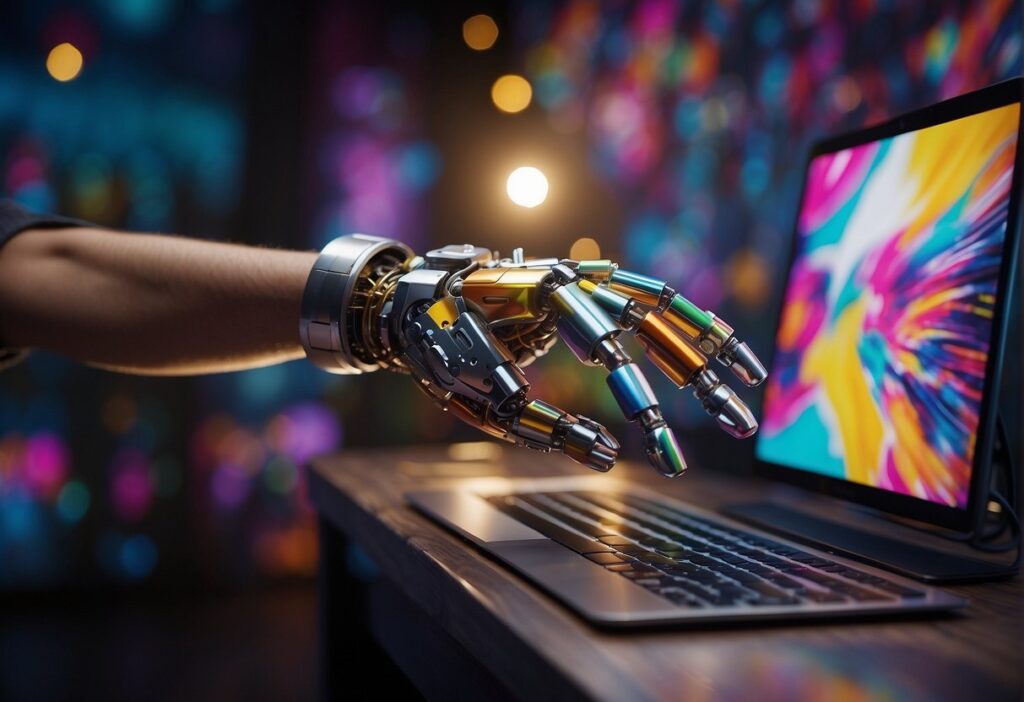
The integration of artificial intelligence in the creative industry is reshaping how art and music are produced, distributed, and valued. This section examines the specific ways AI influences music production, transforms visual art markets, and forecasts the future landscape of creative work.
AI’s Influence on Music Production
AI enhances music production by automating composition, sound design, and mastering processes. Tools leveraging machine learning can generate melodies and harmonies, introducing new sounds that were previously inconceivable. Companies like Amper Music enable creators to produce soundtracks by inputting style and mood, streamlining the creative process.
Transformation of Visual Art Markets
The visual art market is experiencing a fundamental shift due to AI’s ability to create and critique art. Digital platforms enable global dissemination and valuation of AI-generated art, challenging the traditional artist-gallery model. Generative art algorithms are producing pieces that question the essence of creativity and origin, leading to new legal and ethical considerations.
Future of Creative Work with AI
As AI’s presence grows within the creative sector, the future of creative work seems poised for a redefinition. Tools such as generative AI are forecasted to become creative partners, assisting in ideation and execution. According to Harvard Business Review, these advancements will augment human creativity, potentially creating new jobs and changing the skill sets needed in the arts.
Case Studies

The exploration of AI in creative fields has produced a series of noteworthy case studies that showcase the nuanced relationship between machine learning technology and human imagination in art, music, and interactive media.
Deconstructing AI Masterpieces
In the realm of visual arts, AI has facilitated the creation of artworks that challenge traditional notions of authorship and creativity. Scholarly studies, like this one from Oxford Engineering, detail how machine learning techniques have been applied to generate pieces that resonate with human aesthetic sensibilities, yet are born from algorithms. One notable example includes AI recreations of historical paintings, where deep learning has been employed to mimic the styles of legendary artists.
Success Stories in AI-Generated Music
AI-generated music has seen its share of highlights, with algorithms composing pieces that blur the boundaries between human and computer-generated art. An increasing number of musicians and producers are utilizing these AI-driven tools to augment their creative workflow, resulting in music that integrates machine learning’s capability to analyze vast datasets of music theory and cultural preferences.
Breakthroughs in Interactive Installations
Interactive installations have experienced a technological renaissance due to AI integrations, offering enhanced immersive experiences. The fusion of sensors, real-time data processing, and generative algorithms has led to innovative advancements that allow audiences to experience art in dynamic, responsive environments. These breakthroughs not only engage viewers but also inform the ongoing discourse on the possibilities within AI-augmented creative experiences.
Theoretical Perspectives
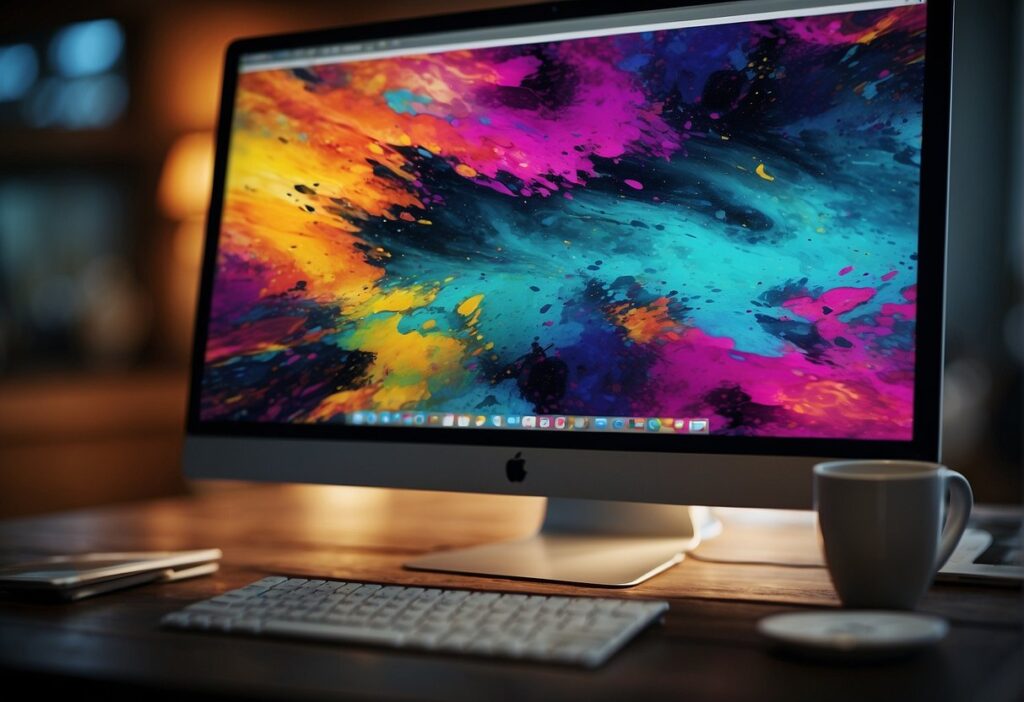
This section explores varying theoretical viewpoints on how artificial intelligence intersects with creativity, particularly in the realms of art and music.
Philosophical Debates on AI Creativity
Philosophers argue about whether AI can truly be creative or if it merely mimics human inventiveness. Some assert that creativity requires consciousness, a quality AI lacks, while others suggest that AI’s capacity to generate novel patterns equates to a form of creativity. Insights into this debate can be found in the paper titled “AI in Art and Creativity: Exploring the Boundaries of Human-Machine Collaboration.”
Cognitive Science Insights into Creativity
Cognitive science brings clarity by studying how both humans and machines generate new ideas. It suggests AI’s pattern recognition and learning algorithms could mimic cognitive processes responsible for human creativity. However, there’s ongoing research to understand if AI can replicate the depth of human experience in creative expressions. The “Understanding and Creating Art with AI: Review and Outlook” sheds light on this aspect.
AI and the Future of Aesthetics
The future of aesthetics may be reshaped by AI’s involvement in the creative process, raising questions about the definition of art and beauty. AI can provide new tools for creating art, affecting how art is evaluated and understood. The potential impact of AI on aesthetics is discussed extensively in the study “Artificial intelligence in fine arts: A systematic review of empirical studies.”
Frequently Asked Questions
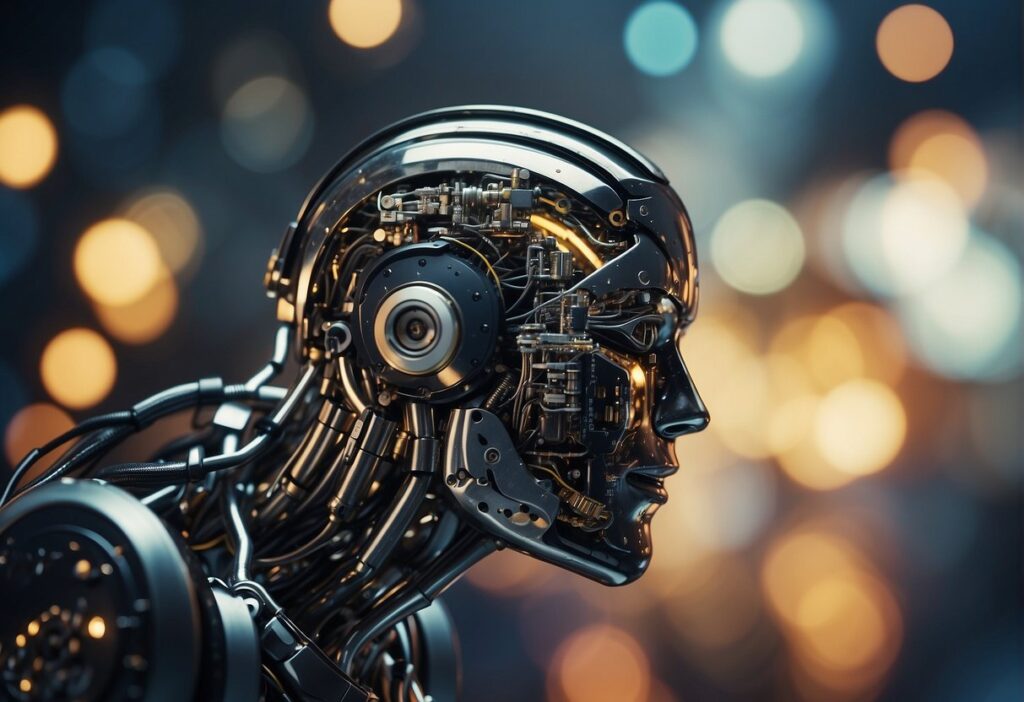
This section addresses common inquiries regarding the intersection of artificial intelligence with the realms of art and music, and explores the multifaceted impacts of these technological advancements.
How can AI influence the process of creating visual art?
Artificial intelligence transforms visual art by offering new tools for experimentation. AI algorithms can analyze vast datasets to generate novel visuals, pushing the boundaries of creativity beyond traditional human capabilities.
In what ways are musicians utilising AI to enhance their musical composition?
Musicians are integrating AI to craft complex musical arrangements and create unique sounds, using machine learning to process and reinterpret vast libraries of musical samples.
What are the implications of AI-generated art on intellectual property rights?
The rise of AI-generated art prompts legal and moral questions regarding ownership and copyright, as it challenges traditional notions of authorship and the origin of creative work.
How does machine learning contribute to the evolution of interactive art installations?
Machine learning algorithms are critical in developing interactive art installations that respond dynamically to audiences, thereby enriching the viewer’s experience through personalized engagement.
Can AI independently create artwork that resonates emotionally with human audiences?
AI is capable of creating artworks that evoke emotions, but it does so by recognizing patterns in data rather than experiencing feelings, leading to a debate on whether such creations can truly resonate on a human level.
What ethical considerations arise from the use of AI in the production of creative content?
The employment of AI in creative endeavors raises ethical issues pertaining to authenticity, bias in algorithms, and the potential displacement of human artists, necessitating a careful balance between innovation and ethical responsibility.
- AI in Retail: Transforming Customer Experience and Personalization Effortlessly
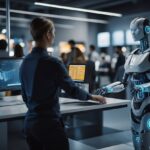
- Responsible AI Development: Ethical Adoption and Transparency

- AI and Creativity: The Fusion of Art, Music, and Machine Learning

- AI-Powered Chatbots in Customer Service
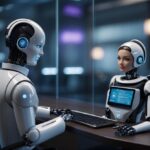
- Visa Bets on Web3 Loyalty

- AI is Eating Finance: How Banks are Embracing Large Language Models

